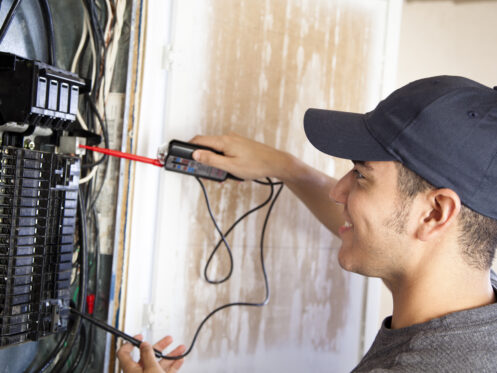Overloads of electricity can be extremely dangerous for your house, possibly resulting in costly damage and hazardous fires. Maintaining a secure and useful living environment requires avoiding these overloads.
At Accurate Home Services in Crandall, TX, we help homeowners assess their electrical capacity and take actionable steps to protect their home’s electrical system. Whether you’re dealing with an older wiring system or simply want to enhance your electrical safety practices, these tips are designed to provide your household peace of mind and protection.
1. Assess Your Home’s Electrical Capacity and Load Limits
One of the most important steps in avoiding electrical overloads is evaluating your house’s electrical capacity and load limits. First, find out how much power your entire system can handle. This information is usually found on your main electrical panel and is expressed in amps. To ensure you’re not reviewing the system’s limitations, compare this to the total load of all the appliances and gadgets in your house. To determine the load, multiply all appliances and devices’ total wattage by the voltage, typically 120V or 240V.
It’s imperative that you take action if your total load approaches or surpasses the panel’s capacity. This could entail updating your electrical panel to meet increased demands or dividing the load among several circuits. Getting advice from a certified electrician can help ensure that your home’s electrical system is safe and effective by providing a comprehensive assessment and assisting with any upgrades or modifications that may be required.
2. Regularly Inspect and Upgrade Electrical Wiring and Outlets
To avoid potential overloads and preserve electrical safety, it’s essential to inspect and upgrade your outlets and electrical wiring regularly. Age, wear, and damage can cause wiring to deteriorate over time, increasing the possibility of faulty connections and fires. Start by visually inspecting outlets and switches for damage, looking for loose fittings, scorch marks, or discoloration. Verify that every outlet satisfies the most recent safety regulations and is grounded.
Upgrade to more contemporary wiring systems for older homes, supporting larger loads and increasing general safety. Furthermore, tamper-resistant outlets can improve security, particularly in houses with small children. If you see any problems or think your wiring might be old, contact a qualified electrician who can do a complete inspection and suggest any necessary upgrades. Dangerous overloads are less likely to occur with an electrical system that is safer and more dependable, thanks to routine maintenance and timely upgrades.
3. Avoid Overloading Circuits With Too Many Devices
To avoid potential overloads and preserve electrical safety, it’s essential to inspect and upgrade your outlets and electrical wiring regularly. Age, wear, and damage can cause wiring to deteriorate over time, increasing the possibility of faulty connections and fires. Start by visually inspecting outlets and switches for damage, looking for things like loose fittings, scorch marks, or discoloration. Verify that every outlet satisfies the most recent safety regulations and is grounded. Upgrade to more contemporary wiring systems for older homes, supporting larger loads and increasing general safety.
Furthermore, tamper-resistant outlets can improve security, particularly in houses with small children. If you see any problems or think your wiring might be old, contact a qualified electrician who can do a complete inspection and suggest any necessary upgrades. Thanks to routine maintenance and timely upgrades, dangerous overloads are less likely to occur with a safer and more dependable electrical system.
4. Use Surge Protectors and Power Strips Wisely
To protect your home’s electrical system and avoid overloads, use power strips and surge protectors sparingly. By shielding your electronics from power surges and voltage spikes brought on by lightning, surge protectors lower the possibility of harm. For optimal protection, select surge protectors with a high joule rating and make sure they are UL-certified. Daisy-chaining multiple power strips together increases the risk of overload and possible fire hazards. Avoid doing this. Instead, use power strips with integrated circuit breakers, and try not to overload them with too many gadgets.
Avoid using power strips when using high-wattage appliances like heaters and refrigerators; instead, plug them straight into wall outlets. You can extend the lifespan and improve the safety of your electrical system and devices by using power strips and surge protectors appropriately.
5. Find and Fix Faulty Appliances and Wiring
Finding and fixing broken appliances and wiring is important for keeping your home safe and avoiding electrical overloads. First, check your appliances for damage signs like frayed cords, scorch marks, or strange noises. Short circuits or overdrawing on your electrical system can be caused by broken appliances, which could be dangerous. If you notice any problems, stop using the appliance right away and get it fixed or replaced.
In the same way, check your home’s wiring for damage or signs of wear, such as wires that are showing, lights that flicker, or circuit breakers that trip often. If you don’t fix bad wiring, it can cause overloads and fires. If you notice any issues, you should get a licensed electrician to look at them carefully and fix or improve them. You should regularly maintain and fix broken appliances and wiring immediately to keep your electrical system safe and working well.
6. Install Circuit Breakers and Fuses for Better Protection
Adding circuit breakers and fuses is one of the most important things you can do to make your home safer for electricity. Circuit breakers are made to turn off electrical circuits automatically when they sense overloads or short circuits. This keeps fires and other damage from happening.
To ensure they work right, choose circuit breakers with the right amperage for each circuit. Fuses do the same thing; they protect individual circuits by melting and breaking the circuit if it gets too busy. To keep your safety, check your fuses often and replace any blown ones. To make things safer, you should get new breakers with extra features like arc-fault or ground-fault detection.
7. Educate Your Household on Safe Electrical Practices
Teaching your family safe ways to use electricity helps avoid accident and keep everyone in the home safe. Start by teaching your family how important it is not to plug too many things into an outlet and not to use broken cords or appliances. Stress that electronics should be unplugged when not in use and that power strips and extension cords should never be used as long-term solutions. Describe the risks of messing with electrical panels or wiring.
8. Schedule Professional Routine Electrical Inspections
It is important to have professional electrical inspections done regularly to keep your home’s electrical system safe and working well. An electrician with the right credentials can carefully check your outlets, circuit breakers, and wiring to find problems before they worsen. These checks help make sure that your system meets modern safety standards and can handle the electrical needs of your home. Check-ups can also find signs of wear, parts that are out of date, or code violations. Routine inspections give you peace of mind and help you avoid future problems that could be dangerous or costly.
Contact Us Today
The safety and effectiveness of your home’s electrical system depend on your ability to prevent electrical overloads. Maintaining your home’s security requires routine inspections and careful use of electrical appliances. If needed, wiring and electrical panel upgrades will help you lower your risk of potential hazards and ensure your electrical setup is still in good working order. Ready to make sure that your Crandall home is electrically safe? Contact us today, and we’ll help you with your electrical needs. We also offer air conditioning, heating, indoor air quality, ductwork, and heat pump services.




